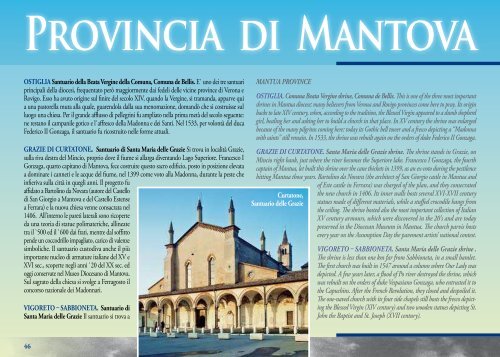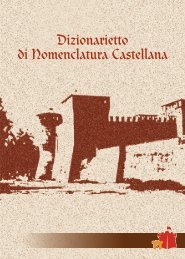luoghi e percorsi tra arte e fede nelle - Provincia di Cremona
luoghi e percorsi tra arte e fede nelle - Provincia di Cremona
luoghi e percorsi tra arte e fede nelle - Provincia di Cremona
You also want an ePaper? Increase the reach of your titles
YUMPU automatically turns print PDFs into web optimized ePapers that Google loves.
<strong>Provincia</strong> <strong>di</strong> Mantova<br />
ostiGlia santuario della Beata vergine della comuna, comuna de Bellis. E` uno dei tre santuari<br />
principali della <strong>di</strong>ocesi, frequentato però maggiormente dai <strong>fede</strong>li delle vicine province <strong>di</strong> Verona e<br />
Rovigo. Esso ha avuto origine sul finire del secolo XIV, quando la Vergine, si <strong>tra</strong>manda, apparve qui<br />
a una pastorella muta alla quale, guarendola dalla sua menomazione, domandò che si costruisse sul<br />
luogo una chiesa. Per il grande afflusso <strong>di</strong> pellegrini fu ampliato nella prima metà del secolo seguente:<br />
ne restano il campanile gotico e l`affresco della Madonna e dei Santi. Nel 1533, per volontà del duca<br />
Federico II Gonzaga, il santuario fu ricostruito <strong>nelle</strong> forme attuali.<br />
Grazie <strong>di</strong> curtatone. santuario <strong>di</strong> santa Maria delle Grazie Si trova in località Grazie,<br />
sulla riva des<strong>tra</strong> del Mincio, proprio dove il fiume si allarga <strong>di</strong>ventando Lago Superiore. Francesco I<br />
Gonzaga, quarto capitano <strong>di</strong> Mantova, fece costruire questo sacro e<strong>di</strong>ficio, posto in posizione elevata<br />
a dominare i canneti e le acque del fiume, nel 1399 come voto alla Madonna, durante la peste che<br />
infieriva sulla città in quegli anni. Il progetto fu<br />
affidato a Bartolino da Novara (autore del Castello<br />
<strong>di</strong> San Giorgio a Mantova e del Castello Estense<br />
a Ferrara) e la nuova chiesa venne consacrata nel<br />
1406. All’interno le pareti laterali sono ricoperte<br />
da una teoria <strong>di</strong> statue polimateriche, allineate<br />
<strong>tra</strong> il `500 ed il `600 dai frati, mentre dal soffitto<br />
pende un coccodrillo impagliato, carico <strong>di</strong> valenze<br />
simboliche. Il santuario custo<strong>di</strong>va anche il più<br />
importante nucleo <strong>di</strong> armature italiane del XV e<br />
XVI sec., scoperte negli anni `20 del XX sec. ed<br />
oggi conservate nel Museo Diocesano <strong>di</strong> Mantova.<br />
Sul sagrato della chiesa si svolge a Ferragosto il<br />
concorso nazionale dei Madonnari.<br />
viGoreto – saBBioneta. santuario <strong>di</strong><br />
santa Maria delle Grazie Il santuario si trova a<br />
I SANTUARI MARIANI<br />
Marian Shrines<br />
Mantua ProvinCe<br />
meno <strong>di</strong> un chilometro da Sabbioneta, inserito in un piccolo agglomerato <strong>di</strong> case. È meta <strong>di</strong> devozione Ceresara. Possenta<br />
ostiGLia. Comuna Beata vergine shrine, Comuna de Bellis. This is one of the three most important<br />
shrines in Mantua <strong>di</strong>ocese; many believers from Verona and Rovigo provinces come here to pray. Its origin<br />
backs to late XIV century, when, accor<strong>di</strong>ng to the <strong>tra</strong><strong>di</strong>tion, the Blessed Virgin appeared to a dumb shepherd<br />
girl, healing her and asking her to build a church in that place. In XV century the shrine was enlarged<br />
because of the many pilgrims coming here: today its Gothic bell tower and a fresco depicting a “Madonna<br />
with saints” still remain. In 1533, the shrine was rebuilt again on the orders of duke Federico II Gonzaga.<br />
per la gente dei <strong>di</strong>ntorni. Nel 1547 venne e<strong>di</strong>ficata la prima chiesa attorno a un pilastro su cui era<br />
affrescata un’immagine della Madonna ritenuta <strong>di</strong>spensatrice <strong>di</strong> grazie. Pochi anni dopo il santuario<br />
fu <strong>di</strong>strutto da un’inondazione del Po, poi ricostruito grazie al Duca Vespasiano Gonzaga, ed affidato<br />
ai Padri Cappuccini. Dopo la rivoluzione francese il convento venne chiuso e il Santuario spogliato.<br />
La chiesa mos<strong>tra</strong> ancora le forme originali. L’interno è a una sola navata con quattro cappelle laterali.<br />
In una <strong>di</strong> esse si trova l’affresco dell’effigie miracolosa della Vergine (1300) e ai due lati le statue lignee<br />
<strong>di</strong> S. Giovanni Battista e <strong>di</strong> S. Giuseppe (1600).<br />
shrine. Annunciazione<br />
della Beata Vergine<br />
Maria church. The<br />
Possenta shrine stands<br />
three km away from<br />
the village centre, and<br />
was built in XIV-XV<br />
Grazie Di Curtatone. santa Maria delle Grazie shrine. The shrine stands in Grazie, on<br />
Mincio right bank, just where the river becomes the Superiore lake. Francesco I Gonzaga, the fourth<br />
captain of Mantua, let built this shrine over the cane thickets in 1399, as an ex-voto during the pestilence<br />
hitting Mantua those years. Bartolino da Novara (the architect of San Giorgio castle in Mantua and<br />
of Este castle in Ferrara) was charged of the plan, and they consecrated<br />
curtatone, the new church in 1406. Its inner walls hosts several XVI-XVII century<br />
santuario delle Grazie statues made of <strong>di</strong>fferent materials, while a stuffed croco<strong>di</strong>le hangs from<br />
the ceiling. The shrine hosted also the most important collection of Italian<br />
XV century armours, which were <strong>di</strong>scovered in the 20’s and are today<br />
preserved in the Diocesan Museum in Mantua. The church parvis hosts<br />
every year on the Assumption Day the pavement artists’ national contest.<br />
viGoreto – saBBioneta. santa Maria delle Grazie shrine .<br />
The shrine is less than one km far from Sabbioneta, in a small hamlet.<br />
The first church was built in 1547 around a column where Our Lady was<br />
depicted. A few years later, a flood of Po river destroyed the shrine, which<br />
was rebuilt on the orders of duke Vespasiano Gonzaga, who entrusted it to<br />
the Capuchins. After the French Revolution, they closed and despoiled it.<br />
The one-naved church with its four side chapels still hosts the fresco depicting<br />
the Blessed Virgin (XIV century) and two wooden statues depicting St.<br />
John the Baptist and St. Joseph (XVII century).<br />
ceresara. santuario della Possenta Chiesa dell`Annunciazione della Beata Vergine Maria Il santuario<br />
della Possenta, isolato, a circa tre chilometri dal centro, sorse <strong>tra</strong> il XIV ed il XV secolo, quando<br />
l`apparizione della Vergine ad una fanciulla si accompagnò al pro<strong>di</strong>gio dell`acqua tornata a scaturire da<br />
un pozzo inari<strong>di</strong>to. In seguito <strong>tra</strong>sformata, la chiesetta mantiene dei tempi più antichi la statua in cotto<br />
della Madonna, tanto venerata da generare una fiera che tuttora si tiene in paese, il 25 marzo.<br />
casalMoro. santuario della Madonna del dosso. Sorge su un dosso costruito dagli abitanti,<br />
affinché il santuario dominasse il paese. Secondo la <strong>tra</strong><strong>di</strong>zione, agli inizi del `600 gli operai <strong>di</strong> una fornace<br />
<strong>di</strong>fettosa poterono riprendere il normale lavoro solo dopo un`invocazione alla Madonna, suggerita<br />
dall`immagine <strong>di</strong> una vicina e<strong>di</strong>cola. Vollero allora onorare quell`immagine e costruirono sul posto<br />
una cappella, che lasciò il posto al santuario attuale. La chiesa colpisce per le belle proporzioni del gusto<br />
neoclassico del tardo Settecento lombardo. Nell’interno prevale invece la ricchezza barocca.<br />
Fontanella Grazioli, Frazione <strong>di</strong> casalroMano. santuario della Malongola<br />
La chiesetta, intitolata alla Beata Vergine Maria è <strong>di</strong> modesta fattura ma ricca <strong>di</strong> affreschi databili <strong>tra</strong><br />
il Tre e il Cinquecento. Un conta<strong>di</strong>no che aveva portato i buoi ad abbeverarsi, rinvenne nel fosso<br />
chiamato Malongola una tavoletta raffigurante la Vergine con il Bambino; collocata l`immagine<br />
nella parrocchiale, il giorno dopo essa fu ritrovata nello stesso luogo, dove si decise allora <strong>di</strong> erigere il<br />
santuario. Su una delle pareti è possibile ammirare una originale Madonna con Bambino su legno <strong>di</strong><br />
chiare origini bizantine. Il <strong>di</strong>pinto della Vergine, secondo la leggenda, venne restituito dalle acque del<br />
fiume Malongola, ritrovato da un conta<strong>di</strong>no al ritorno dal lavoro.<br />
century, after the Blessed<br />
Virgin appeared to<br />
a girl letting water<br />
flow from a dry well.<br />
The church was later<br />
renewed, but still hosts<br />
an original terracotta<br />
statue worshipped by ceresara. santuario della Possenta<br />
believers.<br />
CasaLMoro.<br />
Madonna del Dosso shrine. It stands on an artificial hillock to be higher. Accor<strong>di</strong>ng to the <strong>tra</strong><strong>di</strong>tion,<br />
in early XVII century the workers of a faulty furnace could start their job again after praying Our<br />
Lady, depicted in a near ae<strong>di</strong>cule. They wanted to honour Her by buil<strong>di</strong>ng a chapel, which a shrine<br />
later replaced. The church exteriors show a Lombard neoclassical style, while the interiors are above<br />
all Baroque.<br />
fontaneLLa GrazioLi, CasaLroMano. Malongola shrine. This is a simple small church<br />
de<strong>di</strong>cated to the Blessed Virgin, decked with XIV to XVI century frescoes. A peasant, while farming his<br />
cattle, found a tablet depicting Our Lady with the Child in Malongola <strong>di</strong>tch; he put the tablet in the<br />
parish church, but the day after it was again in the <strong>di</strong>tch, where they then decided to build a shrine.<br />
The wooden Byzantine tablet still hangs on a shrine wall.<br />
46 47



